There Was an Old Lady Who Swallowed a Bat
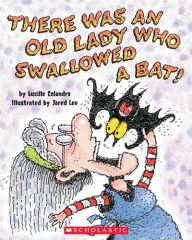
This book by Lucille Colandro is a fun spin on the old lady who swallowed a fly song. Students will enjoy this parody as well.
- After reading the book, investigate
 Batty Old Lady Probability, Students spin to collect all of the items the Batty Old Lady swallowed, and tally each spin on the recording sheet. They then calculate the total spins it took them to get all 7 items, and add that figure to the class data. Teachers may help students analyze the class data and learn about probability in the process. The pdf document includes directions, game mat, picture cards, spinner, recording sheet and writing to learn handout.
Batty Old Lady Probability, Students spin to collect all of the items the Batty Old Lady swallowed, and tally each spin on the recording sheet. They then calculate the total spins it took them to get all 7 items, and add that figure to the class data. Teachers may help students analyze the class data and learn about probability in the process. The pdf document includes directions, game mat, picture cards, spinner, recording sheet and writing to learn handout.
- Download
 Old Lady template to use in retelling the story
Old Lady template to use in retelling the story
- After reading, enjoy the original There Was an Old Lady Who Swallowed a Fly book, enjoy the
 Old Lady and Probability lessons.
Old Lady and Probability lessons.
- Use the
 Old Lady reproducible for students to design their own versions of the story.
Old Lady reproducible for students to design their own versions of the story.
- Use Scholastic's
 Edible Estimation suggestion to incorporate measurement into this book talk. Scroll down the Scholastic page to locate this section.
Edible Estimation suggestion to incorporate measurement into this book talk. Scroll down the Scholastic page to locate this section.
The Very Busy Spider
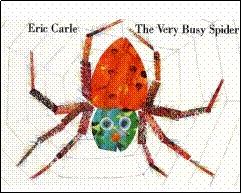
Eric Carle fans will also enjoy The Very Busy Spider and it is a natural introduction to both patterns for younger students or angles for older students.
- Have students complete
 Very Busy Spider Patterns: Math Mat - 1
Very Busy Spider Patterns: Math Mat - 1
- Have students complete
 Very Busy Spider Patterns: Math Mat - 2
Very Busy Spider Patterns: Math Mat - 2
- Have students complete
 Very Busy Spider Patterns: Math Mat - 3
Very Busy Spider Patterns: Math Mat - 3
- Solve some spider number stories using the Spider Web Math Mats
- Challenge older students to complete the
 Spider Search handout which requires students to measure the angles formed by the strands of a spider's web.
Spider Search handout which requires students to measure the angles formed by the strands of a spider's web.
- Solve Insect and Spider Problems to practice multiplication skills.
- Play Spider Math Games to explore coordinate graphing, probability or map coloring.
- See more Spider Math Activities.
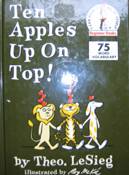
Ten Apples up on Top
Young students will enjoy Ten Apples up on Top by Theo LeSieg. The story is amusing to students and they will wonder if the apples will topple. Because ten is such a pivotal number in our base-ten system, students need many experiences constructing this number. Consider combining this book with the traditional fall apple theme for a strong math lesson.
- Let students draw themselves with a given number of apples up on top for the class Apples up on Top book. Each student is assigned a different number of apples. Each student completes a page for the class booklet by filling in the number and his/her name on the template. Students then make the oval his/her face by adding features and hair. Students then add the correct number of apples up on top. The teacher may bind the book together to create a class book to be read, reread and sent home with students to share with their families.
- Download the
 Apples up on Top template to create a class booklet.
Apples up on Top template to create a class booklet.
- Download the
- Tell apple number stories using 10 apples of two different colors. Students may color in ten-frames to record how many of each color apple. Then ask students to record the same information in a Part-Part-Total diagram, as used in Everyday Mathematics to connect the concrete representation to the symbolic.
- Download a
 Ten Frame & Part-Part-Total recording chart for students to color and record numbers of each color apple used in the number story.
Ten Frame & Part-Part-Total recording chart for students to color and record numbers of each color apple used in the number story.
- Students may also use a
 Generic 3-column chart to record the information from the apple stories.
Generic 3-column chart to record the information from the apple stories.
- Download a

Ten Pumpkins up on Top
Create the fall sequel booklet,  Ten Pumpkins Up on Top, in which students balance pumpkins on their heads. The pdf file contains a cover and a sample student page that may be copied so that students can draw pictures of themselves in costume, balancing 10 pumpkins. Or, create a class counting booklet with each student balancing increasing numbers of pumpkins, as assigned.
Ten Pumpkins Up on Top, in which students balance pumpkins on their heads. The pdf file contains a cover and a sample student page that may be copied so that students can draw pictures of themselves in costume, balancing 10 pumpkins. Or, create a class counting booklet with each student balancing increasing numbers of pumpkins, as assigned.
The Biggest Pumpkin Ever

The Biggest Pumpkin Ever by Stephen Kroll would be a great literature connection for the Huge Pumpkin Estimation Station discussed above or to introduce the class pumpkin sorting activity.
- See suggestions for Pumpkin Math Activities.
- Use coordinate graphing skills to create a Jack-o-Lantern.
- Practice counting skills by completing a Dot-to-Dot Pumpkin.
Bats on Parade
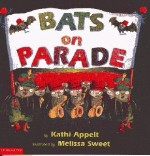
Bats on Parade by Kathi Appelt is a literary introduction to square numbers and the patterns they form as square arrays. The bats march in parade formation and different sections of the band, being different sizes, march in different arrays: "In nine rows of nine those trombones reported, while there, right behind them, the tubas retorted." The pictures and rhyme reinforce the mathematics of the patterns and teachers can easily ask students to predict how many bats will be in the next section or ask them to figure out how many bats are in the whole band before reading those pages. Add this book to your collection of problem-solving literature prompts.
- Multiplication Arrays: The book is a great introduction to multiplication arrays. Use the book illustrations to show students how to use an array to model a multiplication problem then ask students to create arrays for different multiplication facts.
- See examples of
 Student Multiplication Arrays created by a third grade class.
Student Multiplication Arrays created by a third grade class.
- Class on Parade Book: Challenge students to design an array and a rhyme for an original page in the Class on Parade book. Decide on a theme and let pairs of students work on both the math and the language for a page.
- Play the Fat Bat Game to explore the proba bility of a one-die toss.
- See more Bat Math Activities.
Bat Jamboree
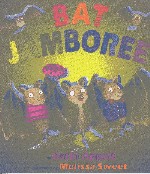
Bat Jamboree by Kathi Appelt introduces the triangular number pattern as bats assemble for the final number beginning with 10 bats in the bottom row, 9 in the next row, etc. to the very top row with 1 bat. Students are introduced to the 55 bats in formation and their various acts but the book "isn't over until the bat lady sings." Students will enjoy this introduction to an important mathematical pattern.
- Teachers can find many problems that build upon this triangular number pattern and extend the experience.
- Student Written Problems: ask students to write original problems that use the triangular number pattern. Being able to write similar problems and solve them require higher-order thinking skills as students apply, synthesize and evaluate both the problems and the solutions.
- Solve Penguin Math problems from the Winter Math Activities. This set of problems builds on the triangular pattern and is sequenced to develop student understanding of the pattern and student use of appropriate tables and charts to organize and record data.
- Play the Fat Bat Game to explore the proba bility of a one-die toss.
- See more Bat Math Activities.
Bats Around the Clock
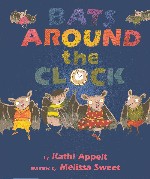
Bats Around the Clock by Kathi Appelt takes a humorous dance through time. Click Dark and American Batstand introduce a new dance each hour. Students move through time, enjoy some rhyme and learn the names of some oldie-but-goodie dances along the way.
- Making Time: For the second reading, give students individual clocks and ask them to move the hour hand to the next hour and say the time before reading the book section for that hour.
- School Time: Provide copies of the
 School Time Template and have students choose a time in the school day, draw the hands on the clock, write a verse and draw an illustration that shows what the class does during that hour. Assemble the individual hours into a class booklet or booklets, depending on the number of students in the class. This activity is easily differentiated to feature time on the hour, or to use the real time schedule of activity changes the class follows. The template clock deliberately shows no hands, allowing teachers to customize the activity to the appropriate mathematical level of students in the class.
School Time Template and have students choose a time in the school day, draw the hands on the clock, write a verse and draw an illustration that shows what the class does during that hour. Assemble the individual hours into a class booklet or booklets, depending on the number of students in the class. This activity is easily differentiated to feature time on the hour, or to use the real time schedule of activity changes the class follows. The template clock deliberately shows no hands, allowing teachers to customize the activity to the appropriate mathematical level of students in the class.
- Play the Fat Bat Game to explore the proba bility of a one-die toss.
- See more Bat Math Activities.

